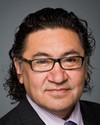It's a fascinating question. I think from the first time that the Inuit met together and mobilized in the early 1970s, there wasn't any preconceived notion of what would happen, or even this idea that there were land claims that were going to happen. This was pre the Calder decision.
It happened mostly in relation to economic development and the threat of economic development projects that would need to be at least rebutted by the assertation of rights within a specific area. That's why, in 1975, the James Bay and Northern Quebec Agreement happened. It was pushed along by Hydro-Québec and the developments there. It was the same thing in the west and the idea of oil and gas pipelines in Mackenzie Valley. In many cases, our path toward the four Inuit regions flowed through economic certainty for Canada and the need for jurisdictions to develop resources in Inuit regions.
There are other stories as well. I think there are remarkable, interesting, and fascinating stories behind where the boundaries are and why they're not, but in general, the principle of certainty, and also the threat of economic development without consultation or agreement with Inuit, drove a lot of the finalization of our land claim agreements.





